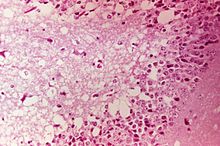Venezuelan equine encephalitis virus
| Venezuelan equine encephalitis virus | |
|---|---|
 |
|
| Virus classification | |
| Group: | Group IV ((+)ssRNA) |
| Family: | Togaviridae |
| Genus: | Alphavirus |
| Species: | Venezuelan equine encephalitis virus |
| Venezuelan equine encephalitis virus | |
|---|---|
| Classification and external resources | |
| ICD-10 | A92.2 |
| ICD-9-CM | 066.2 |
| MeSH | D004685 |
Venezuelan equine encephalitis virus is a mosquito-borne viral pathogen that causes Venezuelan equine encephalitis or encephalomyelitis (VEE). VEE can affect all equine species, such as horses, donkeys, and zebras. After infection, equines may suddenly die or show progressive central nervous system disorders. Humans also can contract this disease. Healthy adults who become infected by the virus may experience flu-like symptoms, such as high fevers and headaches. People with weakened immune systems and the young and the elderly can become severely ill or die from this disease.
The virus that causes VEE is transmitted primarily by mosquitoes that bite an infected animal and then bite and feed on another animal or human. The speed with which the disease spreads depends on the subtype of the VEE virus and the density of mosquito populations. Enzootic subtypes of VEE are diseases endemic to certain areas. Generally these serotypes do not spread to other localities. Enzootic subtypes are associated with the rodent-mosquito transmission cycle. These forms of the virus can cause human illness but generally do not affect equine health.
Epizootic subtypes, on the other hand, can spread rapidly through large populations. These forms of the virus are highly pathogenic to equines and can also affect human health. Equines, rather than rodents, are the primary animal species that carry and spread the disease. Infected equines develop an enormous quantity of virus in their circulatory system. When a blood-feeding insect feeds on such animals, it picks up this virus and transmits it to other animals or humans. Although other animals, such as cattle, swine, and dogs, can become infected, they generally do not show signs of the disease or contribute to its spread.
The virion is spherical and approximately 70 nm in diameter. It has a lipid membrane with glycoprotein surface proteins spread around the outside. Surrounding the nuclear material is a nucleocapsid that has an icosohedral symmetry of T = 4, and is approximately 40 nm in diameter.
Serology testing performed on this virus has shown the presence of six different subtypes (classified I to VI). These have been given names, including Mucambo, Tonate, and Pixuna subtypes. There are seven different variants in subtype I, and three of these variants, A, B, and C are the epizootic strains.
...
Wikipedia
